
The Cessna 152 is an American two-seat, fixed-tricycle-gear, general aviation airplane, used primarily for flight training and personal use. It was based on the earlier Cessna 150 incorporating a number of minor design changes and a slightly more powerful engine with a longer time between overhaul.

The Sopwith Pup was a British single-seater biplane fighter aircraft built by the Sopwith Aviation Company. It entered service with the Royal Flying Corps and the Royal Naval Air Service in the autumn of 1916. With pleasant flying characteristics and good manoeuvrability, the aircraft proved very successful. The Pup was eventually outclassed by newer German fighters, but it was not completely replaced on the Western Front until the end of 1917. Remaining Pups were relegated to Home Defence and training units. The Pup's docile flying characteristics also made it ideal for use in aircraft carrier deck landing and takeoff experiments.
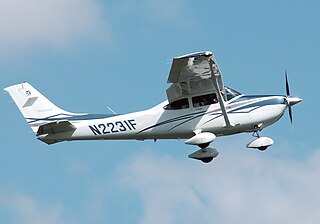
The Cessna 182 Skylane is an American four-seat, single-engined light airplane, built by Cessna of Wichita, Kansas. It has the option of adding two child seats, installed in the baggage area.

The Pitts Special is a series of light aerobatic biplanes designed by Curtis Pitts. It has accumulated many competition wins since its first flight in 1944. The Pitts biplanes dominated world aerobatic competition in the 1960s and 1970s and, even today, remain potent competition aircraft in the lower categories.
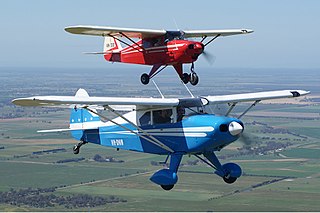
The PA-20 Pacer and PA-22 Tri-Pacer are a family of four-place, strut braced, high-wing light aircraft that were built by Piper Aircraft in the post-World War II period.

The Grumman American AA-1 series is a family of light, two-seat aircraft. The family includes the original American Aviation AA-1 Yankee and AA-1A Trainer, the Grumman American AA-1B Trainer and TR-2, plus the Gulfstream American AA-1C Lynx and T-Cat.

The American Champion 8KCAB Decathlon and Super Decathlon are two-seat fixed conventional gear light airplanes designed for flight training and personal use and capable of sustaining aerobatic stresses between +6g and −5g. The Decathlon entered production in the United States in 1970 as a more powerful and stronger complement to the American Champion Citabria line of aircraft.

The ARV Super2 is a British two-seat, strut-braced, shoulder wing, tricycle landing gear light aircraft designed by Bruce Giddings. Available either factory-built or as a kit, it was intended to be both a cost-effective trainer and an affordable aircraft for private owners. Later called the "Opus", it gained US FAA Light-Sport Aircraft approval in February 2008.
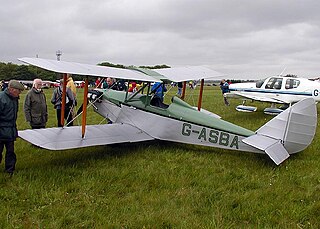
The Currie Wot was a 1930s British single-seat aerobatic biplane aircraft. Plans were sold for home building of the aircraft.

The Isaacs Fury is a British homebuilt sporting biplane designed by John Isaacs as a seven-tenths scale replica of the Hawker Fury fighter.
The UTVA-60 is a Yugoslavian light aircraft of the 1960s. First flying in 1959, it was built by UTVA for both the Yugoslavian armed forces and for civilian use.
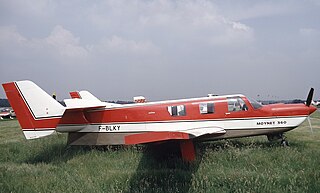
The Moynet 360 Jupiter was a small executive transport built in France in the 1960s. It had an unusual twin-push-pull, single-fuselage configuration. Two prototypes were produced, the second with more power and seating, but no sales resulted.

The Stits SA-3A Playboy is a single seat, strut-braced low-wing monoplane that was designed by Ray Stits for amateur construction. The aircraft was designed and the prototype was completed in a three-month period during 1952. The design went on to become one of the most influential in the post-war boom in aircraft homebuilding.

The Auster J series was a family of British light civil utility aircraft developed in the 1940s and 50s by Auster at Rearsby, Leicestershire.
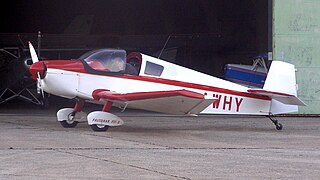
The Falconar F11 Sporty is a Canadian amateur-built aircraft, that was designed by Chris Falconar and produced by Falconar Avia. Falconar supplied it as a kit or as plans for amateur construction. Today both the F11A and E models are available as plans from Manna Aviation.

The Falconar F12A Cruiser is a Canadian amateur-built aircraft, designed by Chris Falconar and originally produced as a kit by Falconar Avia. The aircraft is now supplied as plans for amateur construction by Manna Aviation.

The Viking SF-2A Cygnet, also called the Sisler SF-2A Cygnet and the HAPI SF-2A Cygnet, is an American STOL amateur-built aircraft, designed by Bert Sisler and produced by Viking Aircraft LLC. The aircraft is supplied in the form of plans for amateur construction. The Cygnet first flew in 1973.

The Rihn DR-107 One Design is an American aerobatic homebuilt aircraft that was designed by Dan Rihn and first flown in 1993. The aircraft is supplied by Aircraft Spruce & Specialty of Corona, California in the form of plans and a materials kit for amateur construction.

The Stolp SA-900 V-Star is an American aerobatic homebuilt biplane, currently produced by Aircraft Spruce & Specialty Co in the form of plans for amateur construction. In the 1990s it was also available as a kit from Stolp Starduster Corporation of Riverside, California.
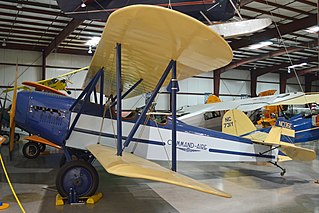
The Command-Aire 3C3 and similar 4C3 and 5C3 are American three-seat open cockpit utility, training and touring biplanes developed by Command-Aire in the late 1920s and early 1930s.




















